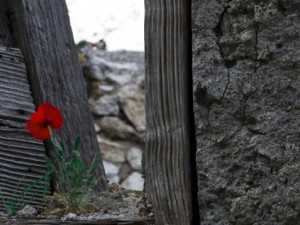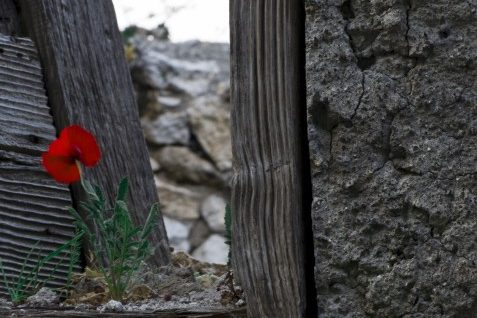Sefirat HaOmer and the Four Days of Remembrance
 The period of time beginning the second night of Pesach and climaxing forty-nine full days later with the Festival of Shavuot can be called a time of “Ruin and Renewal” for the Jewish People. The period includes the following six elements, one encompassing the entire forty-nine day span of time; the others punctuation marks of shared national grief or celebration:
The period of time beginning the second night of Pesach and climaxing forty-nine full days later with the Festival of Shavuot can be called a time of “Ruin and Renewal” for the Jewish People. The period includes the following six elements, one encompassing the entire forty-nine day span of time; the others punctuation marks of shared national grief or celebration:
“Sefirat HaOmer” – Counting of the Omer
The Biblical obligation to count the days between Pesach and Shavuot, where Pesach represents the transition from the physical “ruin” of Slavery to the “renewal” of Physical Freedom, and Shavuot represents the transition from the spiritual “ruin” of idol worship and paganism to the spiritual “renewal” of Monotheism and acceptance of the Torah.
The “Omer” is the reference point because it is the sacrifice that was brought on the second day of Pesach, and the days were counted till the time when the sacrifice of “new” wheat was brought, on Shavuot.
“Yom HaShoah VeHaGevurah” – Memorial Day for the Holocaust and for People who Acted at that Time with Bravery (27 Nisan)
The Holocaust was arguably among the most fearsome tragedies that have befallen the Jewish People in its long history, in which six million Jews, fully two thirds of European Jewry and one third of World Jewry, including one and a half million children, were murdered.
And the murderers were not a People who would normally be called “barbaric.” On the contrary, the majority of the officers of the so-called Concentration “Camps” were medical doctors (!), or doctors of philosophy, or respected professionals. A degree of evil was exhibited which perhaps has never been exceeded in all of human history.
It is not true that the murderers’ evil was unopposed. Tremendous bravery was exhibited by relatively small numbers of Jews and Gentiles, such as at the Warsaw Ghetto, where the Jewish Community acted in concert, and by hundreds of individuals whose efforts resulted in the saving of tens, even hundreds of thousands of lives.
Although the saving of a single life is comparable to the saving of an entire world, the dimensions of the tragedy vastly outweighed all attempts to avert it, and the sweet taste of the good deeds was indistinguishable against the bitterness of the evil.
“Yom HaZikaron” – Memorial Day (4 Iyar)
This Day, the Memorial Day for those who gave their lives in defense of the State of Israel, represents the “price” paid by the Jewish People, in blood, in our time of only hidden miracles, for the State.
The list of martyrs includes more than 23,200 – “HYD”, which stands for “Hashem Yikom DaMam,” May Hashem avenge their deaths, and the number continues, tragically, to grow. May their ultimate sacrifice one day help “purchase” real peace with our neighbors.
We are now (February, 1999) in the midst of a “Peace Process” of somewhat dubious value, which can sometimes be described as “anu medabrim v’hemah lamilchamah,” “we want to talk, but they want war.” (Tehillim 120)
Yom HaAtzmaut – Israeli Independence Day (5 Iyar)
The Day of Independence of the State of Israel, celebrated on the Fifth Day of the Hebrew month Iyar (April 21, 1999 this year) is a day of such historic magnitude that only a day of such quality and importance could balance the horrific magnitude of the Holocaust. May 14, 1948 was the English date of the event, which was celebrated by Jews worldwide with tears of joy.
On this date, the first independent Jewish entity since the time of the Bar Kochba Revolt against Rome, more than eighteen hundred years earlier, came into being.
“Atchalta D’Geulah,” Beginning of the Redemption:
There is an opinion in Jewish Tradition that the Redemption of our People, climaxed by the Arrival of the Mashiach and the Rebuilding of the Temple, will not happen all-at-once, but rather, that it will come as the conclusion of a historical process.
Many supporters of the modern State of Israel believe that our time is, in fact, the “Atchalta D’Geulah,” the beginning of the redemption of the Jewish People. Some contemporary Jews believe that the Creation of the State was a miracle of such stature, that it justifies the saying of Hallel, the special collection of Psalms designated particularly to the expression of gratitude to and praise of G-d.
Although “Medinat Yisrael,” the State of Israel, faces many and severe problems, mainly the terrible conflict between the Secular and the Religious, ultimately a way will be found to unify the People. And Unity, based on shared traditions and beliefs, has always been seen as the key to unlocking the potential of the Jewish People.
“Lag BaOmer” – Thirty Third Day of the “Omer” (18 Iyar):
The break-day in the period of partial mourning which defines the general mood of the Sefirat HaOmer Period. According to tradition, on this day, the plague which was rampant among the students of Rabbi Akiva during the Bar Kochba Revolt, ceased.
The day is also the “Yahrtzeit,” anniversary of the death of Rabbi Shimon bar Yochai, author of the “Zohar,” the “Bible,” or basic book, of Jewish Mysticism. The day is celebrated with bonfires and songs by tens of thousands of Jews at Meron, the burial place of Rabbi Shimon and his son.
In Israel, and throughout the Diaspora, the day is also celebrated with picnics, ballgames, and mock bow-and-arrow play-fighting.
Yom Yerushalayim – Day of Jerusalem (28 Iyar):
This day, regarded by some as even more of a miracle than Yom HaAtzmaut, represented the re-unification of the ancient capital city of Israel, Yerushalayim. Some who are not ready to say Hallel on Independence Day will, nevertheless, say it on the Day of the Re-Unification of Jerusalem.
In the midst of the Six-Day War of June, 1967, Israel warned King Hussein of Jordan to stay out of the conflict. But he made a momentous “miscalculation,” and threw his forces into the battle with Israel. Israel responded by driving the Jordanian Army out of the West Bank of the Jordan River and, in heavy, street by street fighting, out of the Old City of Yerushalayim. The Chief Rabbi of the Israel Defense Forces, Rav Shlomo Goren (later to become Ashkenazic Chief Rabbi of Israel) blew the Shofar at the “Kotel,” the Western Wall of the Temple and, for the first time in 1900 years, Yerushalayim was in Jewish hands.
“Omdot hayu ragleinu b’shearayich, Yerushalayim,”
“We stood within your gates, O Jerusalem,”
“Yerushalayim Habenuyah k’ir shechubra la yachdav;”
“The built-up city of Yerushalayim is like a city that is united;”
“Sha’alu Shelom Yerushalayim, yishlayu ohavav.”
“Pray for the peace of Jerusalem, those who love you will be serene.”
(Tehillim 122)
Make every day count! Sign up for the OU Daily Sefirah Reminder Email.
